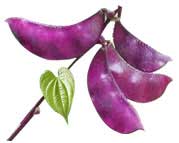 Full List of Fruits
Full List of Fruits  Lablab Fruit
Lablab Fruit
Lablab
Ethnic names - Tonga bean (English), pois nourrice (Spanish), banner bean (Caribbean).
Scientific name - Dolichos lablab (Lablab purpureus).
Origin - They are known to originate in Africa, India and Indonesia.
Appearance - These are Domesticated types and are mostly summer growing annuals or occasionally short-lived perennials. They are vigorously trailing, twining herbaceous plant. Stems are robust and trailing to upright to 3-6 m in length and leaves were trifoliate; leaflets broad ovate-rhomboid and are 7.5-15 cm long, thin, acute at apex, almost smooth above and short haired underneath. Petioles were long and slender.
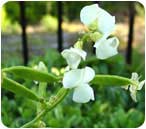
Hyacinth Bean, White Flower
This variety grows beautiful white flowers and thin pods. Young pods are harvested for vegetable use. Plants are vigorous and are often grown along trellis and fences in the Orient. It is almost necessary to harvest young pods every day during the actively growing season in the summer time.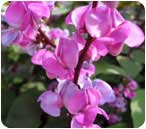
Hyacinth Bean, Purple Flower
This variety is widely grown in subtropical regions in Southern Asia and China. Plants grow beautiful purple flowers and vines, ideal for backyard fence and patio growing. Young deep purple pots are picked for vegetable use.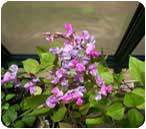
Hyacinth Bean, Asia Purple
This variety grows beautiful purple-red flowers on light green stems and is one the most popular varieties for growing as decorative plants as well as vegetable plants. The plant produces lots of young edible light green pods during summer season. Plants are highly resistant to heat and drought conditions. Black seed with white stripe.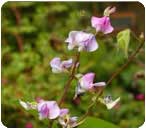
Hyacinth Bean,Asia White
This variety is a tall, indeterminate type plant. Plants are insensitive to day length and will start to produce flowers and beans 40-45 days after sowing. Young pods and seeds are very tender and delicious. This bean grows vigorously in warm climates and produce beans for a long time, more than 3-4 months in subtropical areas.With a protein range between 21% and 28%, Lablab is a high quality choice for summer food plots during a time when antler and fawn development are critical. Lablab is an excellent source of iron and magnesium and a good source of phosphorus, zinc, copper, and thiamin.
| Vitamins (Per 100 g) | |
| Vitamin A | 5.000 mg |
| Niacin | 0.521 mg |
| Folate | 62.00 mcg |
| Vitamin C | 0.028 mg |
| Minerals ( Per 100 g) | |
| Carbohydrate | 9.193 g |
| Calcium | 50.000 mg |
| Iron | 0.740 mg |
| Protein | 2.100 g |
| Fat | 0.201 g |
- Lablab is a dual-purpose legume.
- Flowers and immature pods are commonly used as a vegetable.
- Also used as a fodder legume.
- Lablab is a good green manure, cover crop and in cut-and-carry systems and as a concentrate feed.
- It is more traditionally grown as a pulse crop for human consumption.
- Lablab reduces the risk of heart disease and strokes, cancer.
- These are short-lived perennials.
- Seeds weigh upto 2,000-5,000seeds/kg.
- Flowers are white or blue or purple on short pedicels.
- Pods will be 4-5 cm long, broadly scimitar shaped, smooth and beaked by the persistent style.
- Pods contain upto two to four seeds.
- You can get more proteins from Lablab.
- Leaf does not contain anti-nutritive factors such as tannins.
- Poor frost tolerance.
- This is a host to pests attacking field beans.
Though lablab is an ornamental plant in the United States, this is a popular food in Africa, Asia, and Central and South America. The seeds of Lablab are less than a half inch long and their color ranges from white to brown, red, and black. The plant itself grows as a vine, with large broad leaves.
Lablab grows in a wide range of soils from deep sands to heavy clays. Lablab loses its leaves during prolonged dry seasons. This can tolerate high temperatures. Lablab can be included in the pasta, bread, and grain food group. Despite their beautiful differences in color and taste, all the legumes have similar nutritional value. A serving (1/3 cup of cooked lablab) contains around 80 calories, no cholesterol, lots of complex carbohydrates, and little fat.
Lablab roots are attacked by several nematodes. A stem rot caused by Sclerotinia sclerotiorum sometimes attack the plant under wet conditions. A dual purpose legume and can be used with cereals in smallholder systems. This can be sown with summer grass crops to provide a mixed forage crop system. Lablab haves a high forage quality.
Also this is used as a green manure crop to restore soil fertility. Drought tolerant once established. High grain yields. It acts as a better root disease resistance than cowpeas. Lablab pods can be eaten fresh. Dried beans can be prepared in the same way as other legumes. Previously lablab was included in the genus Dolichos following Linneus, but now it comes under the monotypic genus Lablab. Lablab is primarily self-fertilizing.
Ingredients:
- 1½ cup of Lablab beans
- Salt as required
- 2 tbsp of corn oil
- ¼ tbsp of sugarcrispy fried shallot
- 4 cups of water
- 1/4 tsp of turmeric powder
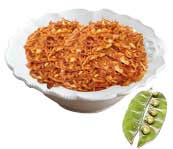
Method:
- Soak the beans in the water over night.
- Remove the skin of the beans the next day.
- In a pan place the beans (skin off), salt, corn oil, water, turmeric powder.
- Cover the pan with the lid and simmer for about 50 minutes or till the beans are cooked.
- Remove from heat and sprinkle with crispy fried shallot.
- Lablab beans with crunchy fried shallots is ready to serve.
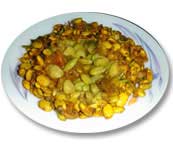
Ingredients:
- 200 grams of Shelled beans
- 1 table spoon oil
- 1/2 teaspoon mustard seeds
- 1/2 teaspoon turmeric powder
- Salt as required
- 1/2 tbsp of Cumin seeds
- 3 Red chillies
- 5 Shallots
- 2 Garlic cloves
- 2 tbsp of Coconut grating
Method:
- In a pan place the beans (skin off), turmeric powder and salt with enough water.
- Cover the pan with the lid and simmer for about 50 minutes or till the beans are cooked.
- Grind all the other items roughly and put it aside.
- In a pan pour oil and add mustard seeds.
- When the mustard seed start to splutter, add the mixture to it and fry.
- Then add the boiled beans to it and stir for a few minutes till you get the right consistency.
Ingredients:
- 1 cup of fresh field bean seeds
- Ghee as required
- Oil as required
- Salt to taste
- Chilli powder to taste
- Asafoetida, a pinch
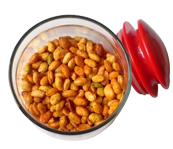
Method:
- Soak field beans in luke warm water for 2 hours.
- Peel out the outer skin and dry it on a clean cloth for a while in shade.
- Deep fry the dried field beans till it gets crisp.
- Now take a spoon of ghee in a pan and add chilly powder, salt and asafoetida to it.
- Add the fried field beans and saute for few mins in very low flame till the spices spread evenly.
- Transfer it to an air tight container and enjoy for a week.
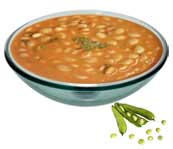
Ingredients:
- 150 gms of Field beans
- 2 chopped Onions
- 1 medium sized chopped Tomato
- 2 Green Chillies
- Red Chilly powder as required
- 1-4 tbsp of Turmeric powder
- 3 tbsp of tamarind Extract
- 3 tbsp of Grated Coconut
- 1 tbsp of Coriander powder
- Few Curry Leaves and Coriander leaves for garnishing
- Salt as required
- Oil - 2 tbsp
Method:
- Cook the beans for 3 to 4 whistles and keep it aside.
- Grind coconut to a fine paste and keep it aside.
- Heat oil in a heavy bottomed vessel, add mustard seeds and curry leaves to it and allow it to splutter.
- Next add onions and fry till it turns golden color.
- Then add tomatoes to it and cook for around 3 minutes.
- Add the cooked beans and little water to the mixture prepared above.
- Add chilly powder, turmeric powder, coriander powder, tamarind extract, salt to the mixture.
- Mix it well and simmer for 5 minutes.
- Add coconut paste and cook for one Min or till the gravy becomes thick.
- Finally add some coriander leaves and curry leaves to it.
|
|
|
|











